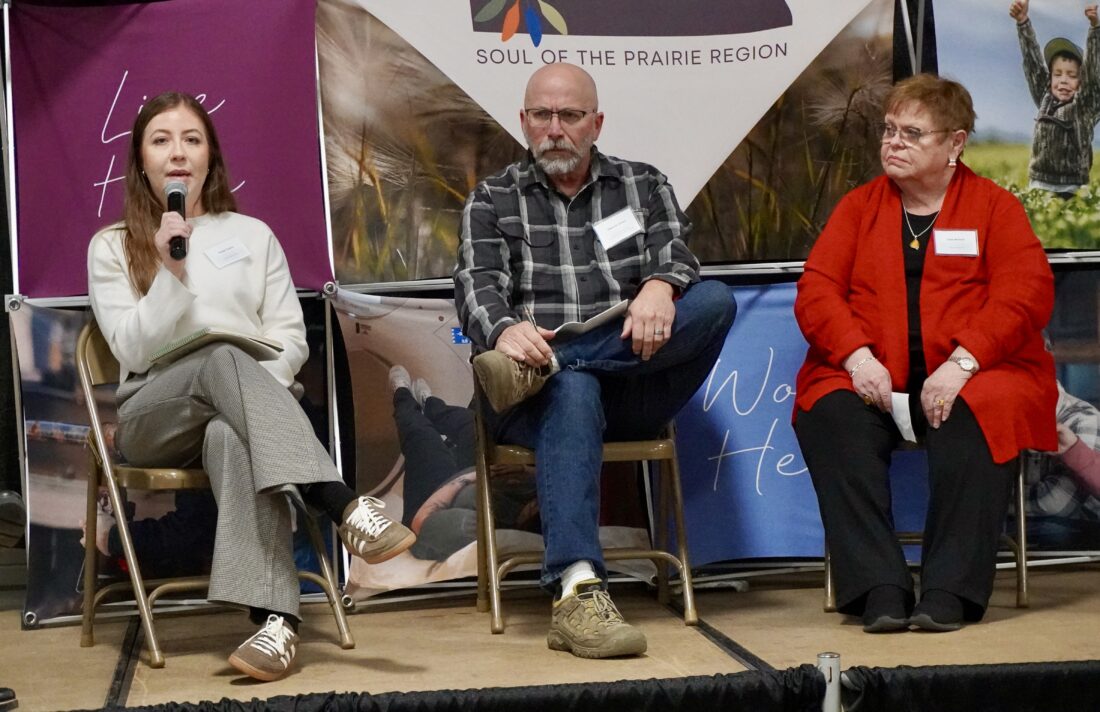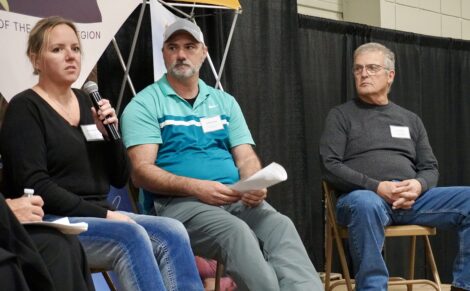Agencies see positives in global workforce recruitment in ND

Jill Schramm/MDN Paige Kuntz, left, with the state’s Global Talent Office speaks at a panel discussion during the Souris Basin Planning Council’s State of Region 2 meeting in the North Dakota State Fair Center Thursday, Oct. 30, as panelists Derrick Gross with CATCH and Deb Nelson with Vision West ND listen at right.
Part of the solution to North Dakota’s workforce shortage is in-migration, including an infusion of foreign talent, according to panelists at the Souris Basin Planning Council’s State of Region 2 meeting in Minot Thursday, Oct. 30.
Resettlement of foreign-born newcomers won’t solve the population problem but can be part of the solution, said Derrick Gross, executive director at Communities Acting Together for Change and Hope (CATCH), an organization that helps prepare rural communities to welcome foreign-born residents.
“If we don’t approach it as part of a purposeful and pre-planned process, it won’t work, and so we can’t have that plan and that process without the local leadership on board and involved,” Gross said.
“You have to get everyone involved in the community and make it part of your overall economic growth and development plan. It doesn’t do any good to bring the new people in, regardless of where they’re from, if they don’t have jobs, if they don’t have housing, if they don’t have transportation, childcare and all these other things that we’ve heard about. So, it takes a communitywide effort and a communitywide plan to make sure that all those things are in place,” he said.
Each of the seven counties in Region 2 has seen a decline in its white population from 2010 to 2022 and a significant increase in other races, said Deb Nelson, administrator with Vision West ND, Dickinson. Mountrail County and Ward County have seen the greatest change.
“They’re coming,” Nelson said. “They’re not necessarily staying. And if we’re going to deal with our workforce, if we’re going to try to keep workforce, we need to provide ways that make people feel like or give them the opportunity to feel like they’re welcome in our communities and that we want them here so that they’ll stay and keep those jobs.”
“Rural communities have really latched on to our programs and our pipelines,” said Paige Kuntz, administrator in the North Dakota Global Talent Office, formerly the Office of Legal Immigration. “Their employers are so eager to try new things.”
She listed a number of North Dakota towns that have welcomed foreign workers to fill critical roles in fields from long-term care to manufacturing.
“One manufacturing employer has hired 24 workers since May through that program. All the workers are still there. Zero percent turnover rate,” she said.
Gross, who has been involved in helping resettle about nine families in seven communities, said the key is having employment and housing in place, making it easier to recruit residents to serve as a support network.
“The communities where that program has been the most successful are the ones where we can get that support network in place so that there are people in the community there to help the families along and help integrate them into the community. The biggest challenge that we face is the language barrier,” he said, noting there are efforts to provide English training in communities and online.
“The most pressing need that any community – I don’t care the size- any community has is to help people who don’t speak English learn to speak English,” Nelson said. “Because if they don’t learn English, they can’t improve themselves in their jobs or in their community.”



